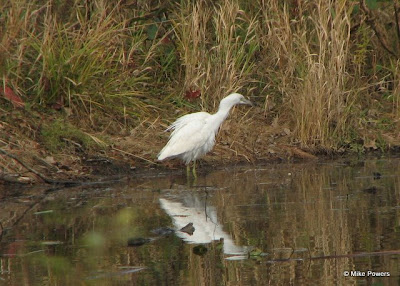Recently I can add a fifth, one that I hope becomes more frequent: 5) rare bird sightings.
I was at my desk Tuesday morning when Tom Johnson, who normally calls me at home about birds I can't get away to chase, called to tell me a Little Blue Heron was standing a couple hundred yards away from my desk. That I can chase.
I grabbed my bins and my camera and joined a handful of other Lab employees watching the snow white heron forage at the edge of the Fuller Wetlands in Sapsucker Woods.
 Immature Little-blues are white while adults are slate-blue.
Immature Little-blues are white while adults are slate-blue.This distinct difference in color morphs makes it unique among
heron species, and it leads to easy misidentification of young ones.
Though a bird typically found in the south-eastern and south-central parts of the U.S., Little Blue Herons are no stranger to our area. They make appearances well away from their breeding grounds, mostly during bouts of post-breeding dispersal. From the BNA Online:
Postbreeding dispersal of nestlings and adults from colonies is relatively random; movement initially is in all directions, but frequently northerly. Some birds disperse northward, especially along the Atlantic Coast, before they move south during migration.
Birds may wander quite a distance away from their breeding areas as shown below. While not expected, it's not uncommon to find a bird anywhere south of the dashed line.
What makes this one extra-special is its November appearance. Wandering birds typically start heading south in mid-September and mostly depart their northern range by mid-October. Since its discovery it's been observed at Sapsucker Woods daily, including this morning. If you are in the area, swing by for a look!
-





1 comment:
Hi nice reading youur post
Post a Comment